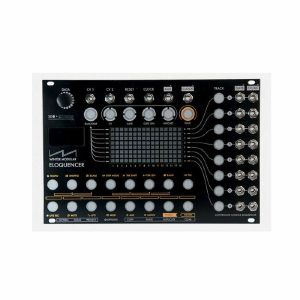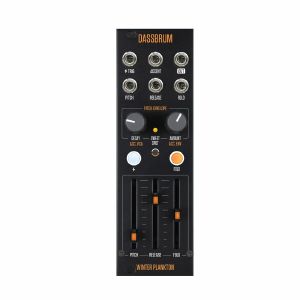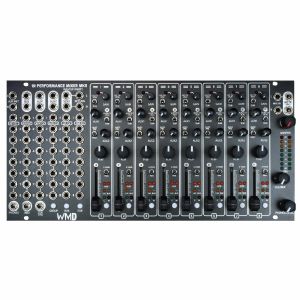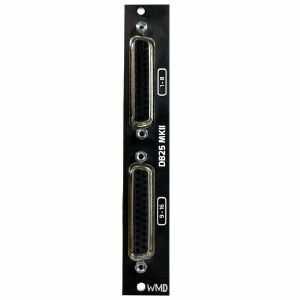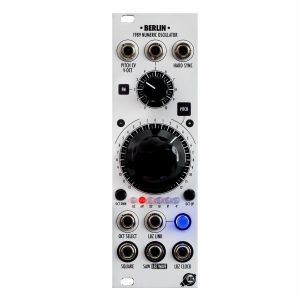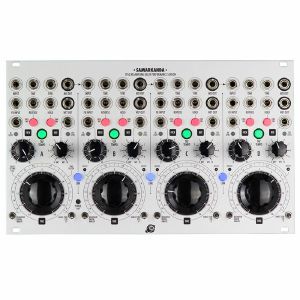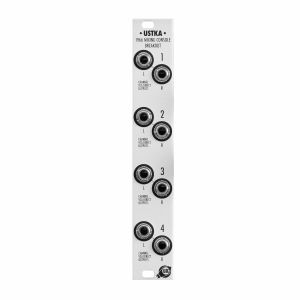Filter
シンセ・モジュール
The Eurorack modular synth format is one of the most exciting areas of music technology. Pioneered by Doepfer, there are now hundreds of brands offering compatible modules of all varieties. You can combine your choice of the best oscillators, filters and much more in order to create a unique, bespoke synth setup which perfectly suits your needs.
Eurorack modules offer the biggest range of options you can imagine, from basic analogue modules which replicate the sound of classic vintage synths, through to digital modules which allow you to explore completely new approaches to making music.
Whether you’re a beginner or a more experienced modular head, you can take your pick of the best modules from leading brands including Mutable Instruments and ALM Busy Circuits.
Our range also includes accessories, cases, patch cables and much more, allowing you to build and customise your perfect modular synth setup.

Winter Modular Eloquencer CV/Gate Sequencer Module (black) (B-STOCK) (random/sequencer synth module)
Cat: 1058072 Rel: 01 Jan 90
B-STOCK: Item refurbished, repaired and in perfect working order.
Notes: ***B-STOCK: Item refurbished, repaired and in perfect working order.***
Nicely creative sequencer module based around controlled randomness. Build patterns and then morph them in real time. Great for live performance as well as studio use.
Supplier notes:
The Eloquencer is a powerful and versatile eurorack sequencer that can be used both as a performance and a composition tool. It's designed to be intuitive, easy to use, and quick to edit. It has been built around the "controlled chance" concept. This means you can decide when and where there will be randomness and how much this randomness will affect your sequences. It features 8 tracks of CVs and Gates in a 16 step disposition, but with the ability to define larger bar counts or chaining patterns to build multiple song parts of 256 steps each.
INPUTS AND OUTPUTS
8 V/oct CV Output
8 Trigger / Gate Output
Reset Input
External Clock Input (configurable. i.e: can be used as a clock divider / multiplier)
Accent Output (configurable)
Clock Output (configurable. i.e: can be used as a clock divider / multiplier)
2 CV Input (assignable to different parameters)
… Read moreNicely creative sequencer module based around controlled randomness. Build patterns and then morph them in real time. Great for live performance as well as studio use.
Supplier notes:
The Eloquencer is a powerful and versatile eurorack sequencer that can be used both as a performance and a composition tool. It's designed to be intuitive, easy to use, and quick to edit. It has been built around the "controlled chance" concept. This means you can decide when and where there will be randomness and how much this randomness will affect your sequences. It features 8 tracks of CVs and Gates in a 16 step disposition, but with the ability to define larger bar counts or chaining patterns to build multiple song parts of 256 steps each.
INPUTS AND OUTPUTS
8 V/oct CV Output
8 Trigger / Gate Output
Reset Input
External Clock Input (configurable. i.e: can be used as a clock divider / multiplier)
Accent Output (configurable)
Clock Output (configurable. i.e: can be used as a clock divider / multiplier)
2 CV Input (assignable to different parameters)
2 in stock $519.82
Winter Modular/Plankton Electronics DassBrum Analogue Kick Drum Module (sound source synth module)
Cat: 1051667 Rel: 05 Dec 24
Analogue kick drum module with waveshaping, sweet spot & custom accent levels - 8HP
Notes: DASSBRUM is a powerful kick module capable of producing a wide variety of sounds, ranging from classic kick tones to complex folded timbres. It features an analogue core processed through a digitally controlled matrix of analogue wave folders and envelopes, offering deep sonic flexibility in a compact 8HP form factor. A built-in sweet spot mode ensures optimal pitch envelope relationships for consistently punchy and dynamic kicks.
Consumption: 120mA +12V /30mA -12V
Width: 8HP
Depth: 29mm
Inputs maximum ratings
Fold type (rear switch): 0/5V
Trigger IN: 5V (>0.5V)
Other inputs: -5/10V
… Read moreConsumption: 120mA +12V /30mA -12V
Width: 8HP
Depth: 29mm
Inputs maximum ratings
Fold type (rear switch): 0/5V
Trigger IN: 5V (>0.5V)
Other inputs: -5/10V
1 in stock $186.91
WMD Performance Mixer MKII 8-Channel Mixer Module (mixer synth module)
Cat: 1021187 Rel: 18 Mar 25
8-channel mixer module - 50HP
Notes: Updated version of WMD's exceptional performance mixer. Full stereo design with improved sound quality, revised layout and increased expandability. An even better version of what was already one of the best mixing solutions in Eurorack.
Supplier's Notes:
Enter the WMD Performance Mixer MKII - Eight years after the MKI was released, the MKII builds on all the valuable feedback received. This is a serious upgrade, with feature enhancements and engineering improvements affecting every bit of the design.
Decisions, decisions, decisions!
If you recall, WMD showed a previous version of the PM MKII a year ago. That version was very similar to the original, with a few enhancements. Primarily focused on manufacturability and overall noise floor with some great recording features. WMD moved to an 8-layer board, replaceable channel strips, developed the MIDI and bootloader, pre/post fader headers, and made it work on both AUXs simultaneously.
Noise Performance - The MKI was alright with noise, there was a little bleed too. Going to 8-layer boards meant I could put ground planes between trace layers, and spread the traces out triple the spacing of what they were on the MKI, this reduces bleed/crosstalk by a factor of about six.
Noise Performance 2 - On the Original, the Level VCA was before the Panning VCAs, which saved on parts/power, but it meant that the Panning VCAs were always connected to the mix bus, adding noise floor that couldn't be attenuated. Making all the channels stereo and putting the Pan circuit first eliminated this problem, now the noise add is controlled by the fader. This did force WMD to make every channel stereo, so the design got simpler through figuring this out.
Panning / Crossfader - The above panning/level improvement made it possible to convert the Pan control into a crossfader, buy simply routing the post pan signals through a switch to the opposing channel, summed at the Level control. This huge improvement allowed the A/&/B input switching scheme to still work on the PM MKII, a bit differently, but it's there in spirit.
Modular Design - The channel strips are all now stereo, and identical, which makes assembly much easier, and lowers the cost. It also makes replacing them easier should a mechanical part fail or get spilled into. Further, the Patchbay, Power board, and Master section are all separate parts, so if there's a failure, they can be quickly swapped without having to RMA the whole unit.
Patchbay - The MKI and rev E MKII still had jacks misaligned with channels. This was a source of frustration for d many users of the PM MKI. And I decided to just be done with it. It didn't make sense to try to put jacks over the channel, it wasted too much space on the panel... So all the jacks go left, keeping the mixer clear of cables, this let me space the knobs out a bit to take up all 3U. It's cleaner, simpler to make, and intuitive to use.
Expandability - It's super modular now, the DB25 can connect to any two headers that spits out audio, they're all the same format across PM MKII and Channels MKII. Pre, post, mixes, connect it however you want. And the connectors can't be hooked to power, meaning no more blown opamps and RMAs to the factory. They're all shrouded too so they won't get bent in shipping!
Features Overview:
Everything is stereo. Inputs, Busses, Auxes, and Cue Mix.
INPUTS: IN LEFT is normalled to IN RIGHT.
GAIN: Each channel has a Gain trim range of -12dB to +20dB, this will let you use line level devices easily.
GAIN CLIP LED: lights red 1dB before clipping the input stage.
LVL FADER: smooth intuitive curve for easily adjusting the mix level on the fly. A yellow indicator shows the level.
MUTE: Press the channel button and the channel will soft mute with a red LED indicator.
… Read moreSupplier's Notes:
Enter the WMD Performance Mixer MKII - Eight years after the MKI was released, the MKII builds on all the valuable feedback received. This is a serious upgrade, with feature enhancements and engineering improvements affecting every bit of the design.
Decisions, decisions, decisions!
If you recall, WMD showed a previous version of the PM MKII a year ago. That version was very similar to the original, with a few enhancements. Primarily focused on manufacturability and overall noise floor with some great recording features. WMD moved to an 8-layer board, replaceable channel strips, developed the MIDI and bootloader, pre/post fader headers, and made it work on both AUXs simultaneously.
Noise Performance - The MKI was alright with noise, there was a little bleed too. Going to 8-layer boards meant I could put ground planes between trace layers, and spread the traces out triple the spacing of what they were on the MKI, this reduces bleed/crosstalk by a factor of about six.
Noise Performance 2 - On the Original, the Level VCA was before the Panning VCAs, which saved on parts/power, but it meant that the Panning VCAs were always connected to the mix bus, adding noise floor that couldn't be attenuated. Making all the channels stereo and putting the Pan circuit first eliminated this problem, now the noise add is controlled by the fader. This did force WMD to make every channel stereo, so the design got simpler through figuring this out.
Panning / Crossfader - The above panning/level improvement made it possible to convert the Pan control into a crossfader, buy simply routing the post pan signals through a switch to the opposing channel, summed at the Level control. This huge improvement allowed the A/&/B input switching scheme to still work on the PM MKII, a bit differently, but it's there in spirit.
Modular Design - The channel strips are all now stereo, and identical, which makes assembly much easier, and lowers the cost. It also makes replacing them easier should a mechanical part fail or get spilled into. Further, the Patchbay, Power board, and Master section are all separate parts, so if there's a failure, they can be quickly swapped without having to RMA the whole unit.
Patchbay - The MKI and rev E MKII still had jacks misaligned with channels. This was a source of frustration for d many users of the PM MKI. And I decided to just be done with it. It didn't make sense to try to put jacks over the channel, it wasted too much space on the panel... So all the jacks go left, keeping the mixer clear of cables, this let me space the knobs out a bit to take up all 3U. It's cleaner, simpler to make, and intuitive to use.
Expandability - It's super modular now, the DB25 can connect to any two headers that spits out audio, they're all the same format across PM MKII and Channels MKII. Pre, post, mixes, connect it however you want. And the connectors can't be hooked to power, meaning no more blown opamps and RMAs to the factory. They're all shrouded too so they won't get bent in shipping!
Features Overview:
Everything is stereo. Inputs, Busses, Auxes, and Cue Mix.
INPUTS: IN LEFT is normalled to IN RIGHT.
GAIN: Each channel has a Gain trim range of -12dB to +20dB, this will let you use line level devices easily.
GAIN CLIP LED: lights red 1dB before clipping the input stage.
LVL FADER: smooth intuitive curve for easily adjusting the mix level on the fly. A yellow indicator shows the level.
MUTE: Press the channel button and the channel will soft mute with a red LED indicator.
3 in stock $1,435.59
Click for better price!
or call +44 20 7424 1960
quote 1021187
quote 1021187
WMD PM DB25 MKII Balanced Output Module For Performance Mixer & Channels MKII (modular synthesiser)
Cat: 1021200 Rel: 18 Mar 25
Balanced output pre/post fader expander module - 4HP
Notes: PM DB25 MKII is an expander output for the MKII versions of the Performance Mixer and Channels.
Pre-fade and Post-fade connections are available for all channels. The DB25 has 16 outputs. All mixer channels are stereo, so one DB25 handles the main PM MKII (either pre or post), and the DB25 can handle 2x Channels (either pre or post).
Simply connect the cable to the Pre or Post headers on the back of the PM MKII or Channels MKII modules to choose pre/post.
The PM MKII has an additional header with both Aux Sends, Master Bus, and Submix Bus.
Connect a DB25 cable of your choice to the front connector and then straight to your DAW or recording interface.
For use with original WMD Performance Mixer, an adapter board can be added on. Please note that width behind panel is increased by 8mm when adapter board is added on. This may require some clever position in your case. The original Performance Mixer still only offers Pre Fader Outputs.
… Read morePre-fade and Post-fade connections are available for all channels. The DB25 has 16 outputs. All mixer channels are stereo, so one DB25 handles the main PM MKII (either pre or post), and the DB25 can handle 2x Channels (either pre or post).
Simply connect the cable to the Pre or Post headers on the back of the PM MKII or Channels MKII modules to choose pre/post.
The PM MKII has an additional header with both Aux Sends, Master Bus, and Submix Bus.
Connect a DB25 cable of your choice to the front connector and then straight to your DAW or recording interface.
For use with original WMD Performance Mixer, an adapter board can be added on. Please note that width behind panel is increased by 8mm when adapter board is added on. This may require some clever position in your case. The original Performance Mixer still only offers Pre Fader Outputs.
4 in stock $253.27
Click for better price!
or call +44 20 7424 1960
quote 1021200
quote 1021200
Xaoc Devices Berlin 1989 Numeric Oscillator Module (oscillator synth module)
Cat: 1019439 Rel: 22 May 24
Numeric oscillator module - 8HP
Notes: On the surface, Xaoc Devices Berlin is a simple compact VCO offering square and saw waves with hard sync, FM input and octave switching. The most interesting part lies behind the panel and that is the Leibniz Binary Subsystem interface, namely LBZ out and LBZ in. The front panel LBZ LINK button and its corresponding gate input switch between the default saw wave and a signal that has been passed through any Leibniz module (or a combination of Leibniz modules) connected to Berlin. Add Xaoc Devices Jena for wave processing and the output is no longer a simple saw wave - you now have a vintage-style wavetable oscillator with a penchant for the experimental due to its open, hackable nature.
Berlin operates in a way similar to the classic PPG Wave and Fairlight CMI synths and employs a variable sample rate of an extremely wide-range internal clock. As the sample rate changes with the oscillator frequency, Berlin's internal square and saw waves exhibit no aliasing effect. The whole frequency range spans from 30 seconds in LFO mode up to 250 kHz (!) with the clock reaching an astounding 20 MHz. Add to that voltage control over all parameters and the result is a highly versatile module capable of creating a significantly diverse palette of unusual waveforms. To better understand the device and avoid common pitfalls, it is strongly advised that you read through the entire manual before using the module.
Technical details:
8hp, 30mm deep (including the ribbon cable and bracket)
Current draw: +40mA/-20mA
Reverse power protection
Connectivity:
Berlin connects to all modules compatible with the Leibniz Binary Subsystem: Drezno II, Lipsk, Gera, Jena, Erfurt, Poczdam, Rostock, Ostankino II, and Odessa.
… Read moreBerlin operates in a way similar to the classic PPG Wave and Fairlight CMI synths and employs a variable sample rate of an extremely wide-range internal clock. As the sample rate changes with the oscillator frequency, Berlin's internal square and saw waves exhibit no aliasing effect. The whole frequency range spans from 30 seconds in LFO mode up to 250 kHz (!) with the clock reaching an astounding 20 MHz. Add to that voltage control over all parameters and the result is a highly versatile module capable of creating a significantly diverse palette of unusual waveforms. To better understand the device and avoid common pitfalls, it is strongly advised that you read through the entire manual before using the module.
Technical details:
8hp, 30mm deep (including the ribbon cable and bracket)
Current draw: +40mA/-20mA
Reverse power protection
Connectivity:
Berlin connects to all modules compatible with the Leibniz Binary Subsystem: Drezno II, Lipsk, Gera, Jena, Erfurt, Poczdam, Rostock, Ostankino II, and Odessa.
2 in stock $206.82
Xaoc Devices Samarkanda 1953 Resampling Delay Performance Station Module (effect synth module)
Cat: 1079380 Rel: 27 Mar 25
A high versatile digital quad delay module.
Notes: A super impressive offering from Xaoc, the Samarkanda is a quad delay module designed for hands-on, real-time performance. Dial in everything from loops to stereo delays, resonators, modulation effects and much more.
Supplier's Notes:
Xaoc Devices Samarkanda is a digital quad delay module with extensive patching capabilities and a lot of flexibility for signal mangling. It can be used as four entirely independent delays, a dual stereo delay, a complex/multi-tap or multi-channel delay, a quad/polyphonic resonator, dual chorus, dual flanger, reverb, looper (with sound on sound!), and granulator, or any combination of those. You can reverse the delayed signal, hold it, squeeze and stretch it beyond all recognition and still go back to the original piece of audio captured in the buffer! The internal lossless normalization (the signal doesn't leave the digital domain) combined with top-notch components (including 24-bit AKM converters and 32-bit internal processing) are responsible for high sound quality. Samarkanda has been conceived in the truly modular spirit. Not only can you control almost all its features remotely with CV/gates, but the external feedback path gives you the opportunity to process the delayed signal with other modules.
Samarkanda offers a wide range of delay times beginning at a mere 0.5ms and reaching up to 15 seconds per channel. That means that, by stacking its four channels, you can achieve up to one minute delay! There are two operating modes switchable individually for each channel. Analogue delivers pitch changes that resemble classic analogue tape and BBD delays. When you combine it with the looping Hold function, you can play Samarkanda with any 1V/octave CV source. By using the Sync function you can even loop single wave cycles. The Digital mode gives you a granular buffer-scrubbing effect (no pitch change) across the whole delay time range. You can seamlessly switch back and forth between modes without losing any information. You can use Samarkanda for multiple tasks at the same time - from four independent delay lines through any combination of channels processing the same signal up to a quad behemoth. You can also use the linking feature for ease of operation (the first channel in the chain acts as the main control source for the others).
As most settings operate on a per-channel basis, you can freely combine different features (such as analog/digital behaviour, delay time range, reverse and hold functions, etc.) in a configuration of your choosing. You can synchronize each of its channels separately to a different source, either via the Sync input, or by using the tap-tempo functionality (with multiplication and division galore). Should you ever get lost, the Purge button comes in handy when/if things start to spiral out of control!
… Read moreSupplier's Notes:
Xaoc Devices Samarkanda is a digital quad delay module with extensive patching capabilities and a lot of flexibility for signal mangling. It can be used as four entirely independent delays, a dual stereo delay, a complex/multi-tap or multi-channel delay, a quad/polyphonic resonator, dual chorus, dual flanger, reverb, looper (with sound on sound!), and granulator, or any combination of those. You can reverse the delayed signal, hold it, squeeze and stretch it beyond all recognition and still go back to the original piece of audio captured in the buffer! The internal lossless normalization (the signal doesn't leave the digital domain) combined with top-notch components (including 24-bit AKM converters and 32-bit internal processing) are responsible for high sound quality. Samarkanda has been conceived in the truly modular spirit. Not only can you control almost all its features remotely with CV/gates, but the external feedback path gives you the opportunity to process the delayed signal with other modules.
Samarkanda offers a wide range of delay times beginning at a mere 0.5ms and reaching up to 15 seconds per channel. That means that, by stacking its four channels, you can achieve up to one minute delay! There are two operating modes switchable individually for each channel. Analogue delivers pitch changes that resemble classic analogue tape and BBD delays. When you combine it with the looping Hold function, you can play Samarkanda with any 1V/octave CV source. By using the Sync function you can even loop single wave cycles. The Digital mode gives you a granular buffer-scrubbing effect (no pitch change) across the whole delay time range. You can seamlessly switch back and forth between modes without losing any information. You can use Samarkanda for multiple tasks at the same time - from four independent delay lines through any combination of channels processing the same signal up to a quad behemoth. You can also use the linking feature for ease of operation (the first channel in the chain acts as the main control source for the others).
As most settings operate on a per-channel basis, you can freely combine different features (such as analog/digital behaviour, delay time range, reverse and hold functions, etc.) in a configuration of your choosing. You can synchronize each of its channels separately to a different source, either via the Sync input, or by using the tap-tempo functionality (with multiplication and division galore). Should you ever get lost, the Purge button comes in handy when/if things start to spiral out of control!
! low stock $588.39
Xaoc Devices Ustka 1966 Mixing Console Breakout Module (modular synthesiser)
Cat: 1033095 Rel: 19 Jul 24
Mixing console breakout module for Ostrawa - 4HP
Notes: Ustka ['ustka] is a simple passive expander module for the Ostrawa stereo mixing console. It offers direct access to four pairs of stereo signals before they are combined into the mixed signal at the output of Ostrawa.
Ustka's main application is interfacing with external multichannel devices like computer audio interfaces and hardware multitrack recorders.
For detailed description, please refer to the manual.
Features
Per-channel VCA direct outputs
Modular or line signal level
Technical details
Eurorack standard compliant
4hp wide, 31mm deep (including cable bracket)
Current draw: no current draw (passive device)
… Read moreUstka's main application is interfacing with external multichannel devices like computer audio interfaces and hardware multitrack recorders.
For detailed description, please refer to the manual.
Features
Per-channel VCA direct outputs
Modular or line signal level
Technical details
Eurorack standard compliant
4hp wide, 31mm deep (including cable bracket)
Current draw: no current draw (passive device)
1 in stock $68.56
Click for better price!
or call +44 20 7424 1960
quote 1033095
quote 1033095

 USD
USD





